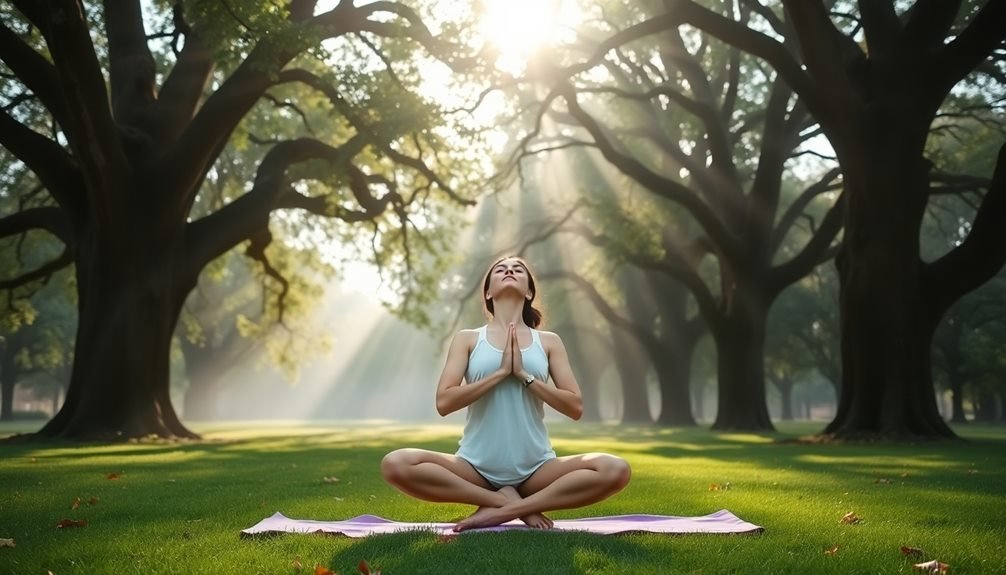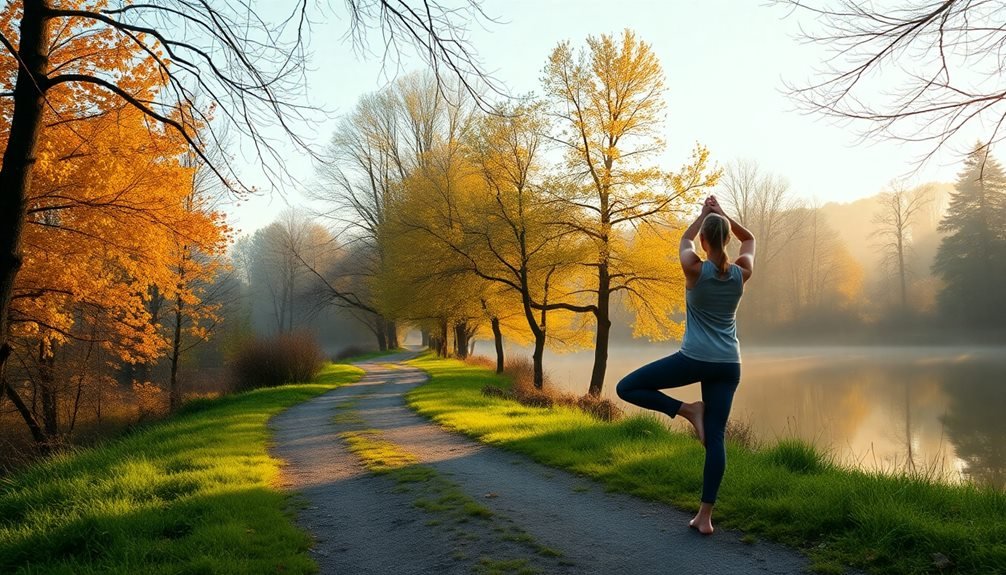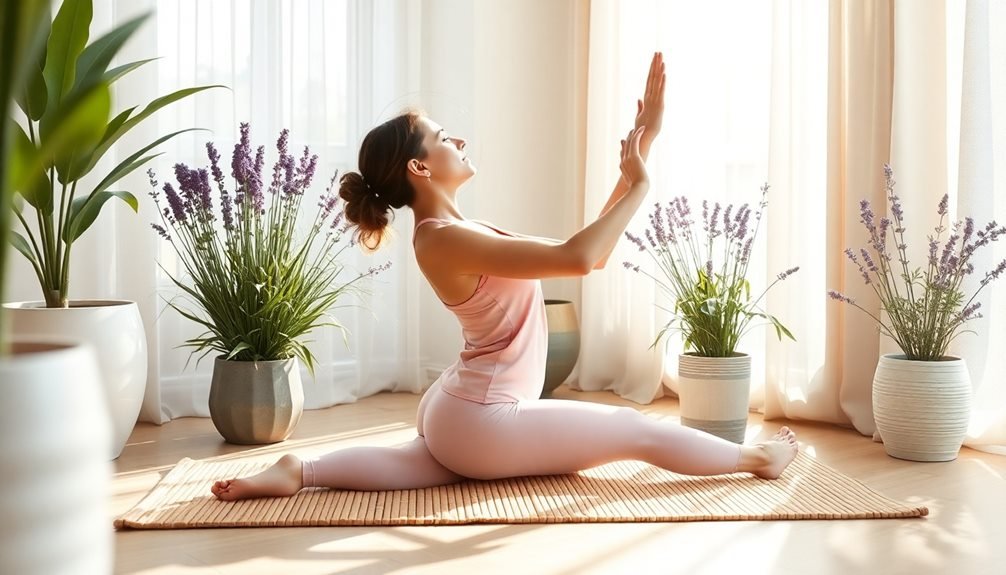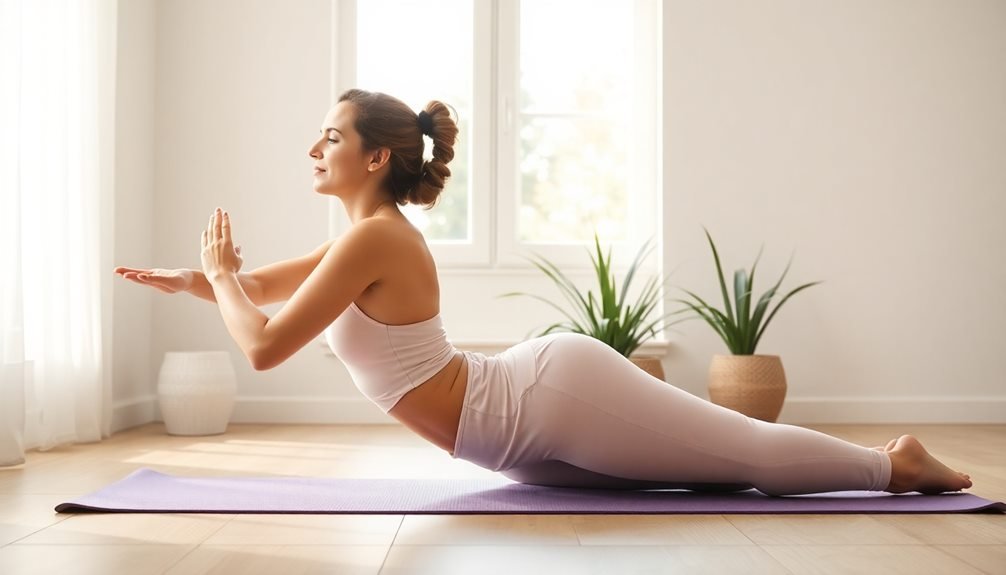Seven gentle outdoor activities can help you achieve stress-free fitness while connecting with nature. You'll find peace and strength through morning nature walks, which burn calories while boosting vitamin D levels. Outdoor tai chi practice enhances balance and mental focus, while mindful gardening creates a sustainable fitness routine. Swimming in natural waters offers full-body exercise and mood enhancement. Bird watching strolls combine gentle movement with wildlife observation, and forest bathing reduces stress through mindful woodland walks. Finally, gentle park yoga improves flexibility and mental clarity. These activities provide a natural path to both physical and mental well-being.
Morning Nature Walks

Starting your day with a morning nature walk offers one of the gentlest ways to improve your fitness level. You'll benefit from the combination of fresh air, natural light, and low-impact movement that helps wake up your body and mind. A 30-minute walk through parks, wooded trails, or quiet neighborhoods can burn 150-200 calories while reducing stress hormones and increasing vitamin D production.
To maximize your morning walk's effectiveness, wear comfortable walking shoes and dress in layers you can remove as your body warms up. Start at a relaxed pace for the first five minutes to let your muscles adjust. You don't need to power walk – maintain a comfortable stride that allows you to breathe easily and notice your surroundings.
Choose routes with varying terrain when possible, as slight inclines and natural surfaces engage more muscle groups than flat pavement. Listen to birds, observe seasonal changes, and breathe deeply as you walk. You'll find it's easier to maintain this habit when you focus on the experience rather than treating it as exercise.
Try to walk at least three mornings per week, gradually increasing your distance as your stamina improves.
Outdoor Tai Chi Practice
Among the most serene outdoor fitness activities, Tai Chi offers a perfect blend of gentle movement and mindful meditation. When you practice this ancient Chinese art form outdoors, you'll connect with nature while improving your balance, flexibility, and mental focus.
Choose a quiet spot in a park, garden, or any open space where you won't be disturbed.
You'll want to start with basic Tai Chi stances and movements, focusing on your breathing and maintaining proper posture. The slow, flowing movements help reduce stress while strengthening your muscles and improving coordination.
As you practice outdoors, you'll benefit from fresh air and natural vitamin D from sunlight.
Begin your outdoor sessions during early morning or late afternoon when temperatures are mild. Wear comfortable, loose-fitting clothes that allow free movement, and choose flat, stable ground for safety.
If you're new to Tai Chi, consider taking a few indoor classes first to learn proper form before moving your practice outside. You can also find beginner-friendly Tai Chi videos online to guide your outdoor sessions.
Remember to stay hydrated and move at your own pace.
Mindful Gardening

Creating a mindful garden starts with planting healing herbs like lavender, chamomile, and mint that you'll use in teas and aromatherapy.
You can design a meditative space by arranging your plants in a circular pattern, leaving room for a small sitting area where you'll connect with nature.
As you tend to your therapeutic garden, you'll benefit from both the physical activity of gardening and the calming presence of your healing plants.
Growing Healing Herbs First
Mindful herb gardening offers a peaceful path to outdoor fitness while producing natural remedies for your well-being. Start by selecting three to five easy-to-grow medicinal herbs like lavender, peppermint, chamomile, or lemon balm. You'll need to prepare a small garden bed or several containers with well-draining soil in a sunny location.
The physical activity begins with soil preparation, which engages your core muscles and upper body as you dig, mix compost, and remove weeds. While planting your herbs, practice mindful movements by focusing on your breath and the sensation of soil between your fingers.
You'll burn calories through regular maintenance tasks like watering, pruning, and harvesting. As your herbs grow, you'll develop a sustainable fitness routine through daily garden check-ups. Bend carefully to inspect leaves, stretch to reach spreading stems, and squat to pull unwanted weeds.
Once mature, you can harvest your herbs for teas, tinctures, or aromatherapy. The reward of growing healing herbs extends beyond exercise – you're creating a living pharmacy while improving flexibility, strength, and mental clarity through gentle, purposeful movement.
Meditative Garden Space Design
Building on the healing power of herbs, a meditative garden space offers a deeper dimension to your outdoor wellness journey. You'll want to create distinct zones that engage your senses while providing peaceful spots for reflection and gentle movement.
Start by mapping your garden into purposeful areas that flow naturally from one to another. Consider these essential elements for your meditative space:
| Element | Purpose |
|---|---|
| Stone Path | Creates mindful walking meditation routes |
| Water Feature | Provides calming sounds and visual focus |
| Seating Nook | Offers comfortable spot for meditation |
| Privacy Screen | Maintains peaceful seclusion with plants |
Position your seating to face east for morning meditation, and include wind chimes for gentle sound therapy. You'll benefit from incorporating curves rather than straight lines, as they're more soothing to the eye and mind. Select plants that move gracefully in the breeze, such as ornamental grasses or bamboo, to create natural movement. Don't forget to include textural elements like smooth stones and soft moss that invite touch and connection with nature.
Swimming in Natural Waters
Swimming in lakes, rivers, or oceans offers you a unique blend of physical exercise and nature's therapeutic effects, helping reduce stress while building strength and cardiovascular fitness.
You'll want to prioritize safety by checking local water conditions, swimming with a buddy, and staying within designated areas marked for recreational swimming.
Whether you're floating in a calm mountain lake or paddling along a coastal shoreline, you can find suitable natural swimming spots by researching local water bodies and joining community swimming groups that know the safest locations.
Health Benefits of Nature
Taking a dip in natural waters offers unique physical and mental health advantages that indoor pools can't match. When you swim in lakes, oceans, or rivers, you'll expose yourself to natural elements that strengthen your immune system and improve your body's resistance to common ailments.
The varying temperatures and currents also help build cardiovascular endurance more effectively than swimming in controlled environments.
Nature's therapeutic effects extend beyond physical benefits. You'll experience reduced cortisol levels and decreased anxiety as you immerse yourself in natural settings. The negative ions present near moving water and the peaceful sounds of nature trigger the release of feel-good hormones like serotonin, helping you combat stress and improve your mood naturally.
Swimming outdoors also provides vitamin D through sunlight exposure, which strengthens your bones and supports immune function.
The challenging environment of natural waters engages more muscle groups as you adapt to changing conditions, improving your balance and coordination. You'll also burn more calories compared to indoor swimming due to the additional effort required to navigate natural currents and temperature variations.
Safe Swimming Practices
Before heading out into natural waters, you'll need to follow essential safety protocols to protect yourself from potential hazards. Never swim alone, and always check local weather conditions and water temperatures before entering. Choose designated swimming areas with lifeguards when possible, and stay within sight of the shore.
| Safety Measure | Why It Matters |
|---|---|
| Check water depth | Prevents diving injuries in shallow areas |
| Watch for currents | Helps avoid getting pulled away from shore |
| Wear bright colors | Makes you visible to boats and rescuers |
| Know local wildlife | Reduces encounters with dangerous species |
If you're swimming in lakes or rivers, you'll want to wear water shoes to protect your feet from sharp rocks and underwater debris. Keep your swimming sessions shorter in natural waters than you would in pools, as temperature fluctuations and currents can drain your energy faster. Don't enter the water if you notice unusual discoloration, strong odors, or warning signs about water quality. When swimming in ocean waters, pay attention to flag warnings and tide schedules. You'll also need to watch for rip currents, which you can identify by choppy, discolored water or gaps in the breaking waves.
Best Swimming Spots
Natural swimming holes offer an unmatched outdoor experience that combines exercise with scenic beauty. You'll find some of the safest and most enjoyable swimming spots in lakes, where calm waters and gradual depth changes make for ideal conditions.
Look for public beaches with designated swimming areas, lifeguard stations, and water quality monitoring.
When seeking ocean swimming locations, opt for protected bays or coves where waves are gentler and currents are less intense. Many coastal areas maintain supervised beaches with flags indicating safe swimming conditions.
You'll want to check local tide tables and weather forecasts before heading out.
For river swimming, search for wider sections where the water moves slowly and there's minimal underwater debris. Swimming holes below small waterfalls often provide deep, clear water and natural rock formations for resting.
Before diving in, you should verify that the spot is officially sanctioned for swimming and has easy access points.
Don't forget to research seasonal conditions, as water levels and temperatures can vary considerably throughout the year.
The best swimming spots typically offer amenities like parking, restrooms, and emergency services nearby.
Bird Watching Strolls

A leisurely bird watching stroll combines the benefits of light exercise with the joy of wildlife observation. You'll find that walking at a moderate pace while scanning the environment for birds helps maintain focus and mindfulness, making it an excellent stress-reducing activity.
| Essential Items | Benefits |
|---|---|
| Binoculars | Improved cardiovascular health |
| Bird guide book | Enhanced mental focus |
| Comfortable shoes | Reduced stress levels |
| Water bottle | Better nature connection |
Before heading out, choose trails with known bird populations and varying habitats like wetlands, woods, or meadows. You'll want to start early morning or late afternoon when birds are most active. Keep your movements slow and deliberate to avoid startling the wildlife.
Remember to maintain proper posture while walking and holding your binoculars. Position them at chest level when walking, then raise them smoothly when you spot a bird. Don't forget to pack your bird guide and wear weather-appropriate clothing in neutral colors. You can gradually increase your walking distance as your stamina improves, making bird watching an adaptable fitness activity that grows with your abilities.
Forest Bathing
Japanese-inspired forest bathing, known as "shinrin-yoku," takes mindful nature immersion to a deeper level than casual hiking.
You'll discover a slow, meditative approach to experiencing nature through all your senses, rather than simply walking through it. This practice can greatly reduce cortisol levels and blood pressure while boosting your immune system.
Unlike traditional exercise, forest bathing doesn't require any special equipment or physical prowess. You'll simply need to find a wooded area and engage your senses fully in the experience.
Research shows that phytoncides, natural compounds released by trees, can enhance your body's natural killer cells and improve overall wellness.
Key elements of forest bathing include:
- Moving slowly and deliberately through the forest, paying attention to each step
- Focusing on deep, rhythmic breathing while taking in the forest air
- Touching natural elements like tree bark, leaves, and moss mindfully
- Using all senses to observe details: the sound of wind, scent of pine, taste of clean air
You can practice forest bathing for as little as 20 minutes or extend it to several hours, depending on your schedule and needs.
Gentle Park Yoga

Taking your yoga practice outdoors into a park setting combines the healing benefits of nature with gentle movement. You'll find that practicing yoga in a park environment enhances mindfulness while providing fresh air and natural vitamin D from sunlight. The varied terrain of parks also offers opportunities to modify your poses and engage different muscle groups.
Choose a flat, grassy area away from busy pathways to set up your mat. If you don't have a mat, a large towel works well on dry grass. Start with simple standing poses like Mountain Pose and Sun Salutations, which help you connect with your surroundings. Tree Pose becomes more meaningful when you're actually surrounded by trees, helping you focus on balance and stability.
You'll want to practice at ideal times – early morning or sunset hours offer comfortable temperatures and fewer distractions. Pay attention to weather conditions and dress in layers.
Keep your sequences flowing but gentle, and don't hesitate to modify poses based on the terrain. Remember to bring water and consider joining or forming a park yoga group for regular practice sessions.
Frequently Asked Questions
How Can I Maintain Outdoor Fitness Routines During Extreme Weather Conditions?
You'll need to adapt your outdoor workouts during harsh weather. Try timing activities during milder parts of the day, wear appropriate layers, stay hydrated, and have indoor backup plans when conditions become unsafe.
What Safety Equipment Should I Carry for Solo Outdoor Wellness Activities?
You'll need a first-aid kit, emergency phone, ID, water, weather-appropriate gear, and whistle. Don't forget to share your route with someone and bring a GPS device or compass for navigation.
How Long Should Beginners Practice These Activities to See Stress-Reduction Benefits?
You'll notice stress relief within 10-15 minutes of starting any mindful activity. Try practicing 2-3 times weekly for 30 minutes each session. Stick with it for 4-6 weeks to develop lasting benefits.
Are These Activities Suitable for People With Mobility Issues or Chronic Pain?
You can find suitable activities despite mobility issues or chronic pain. Many exercises can be modified to fit your needs, and you'll want to start slowly, consulting your doctor about appropriate adaptations.
What Alternatives Can I Do Indoors When Outdoor Activities Aren't Possible?
You can try gentle yoga, chair exercises, stretching routines, tai chi, indoor walking, or light resistance bands at home. Don't forget meditation and deep breathing exercises to maintain your fitness indoors.
In Summary
You'll find that these gentle outdoor activities offer more than just physical benefits – they're gateways to both wellness and tranquility. Whether you're watching birds take flight or feeling the morning dew during your nature walk, you're nurturing your body and mind simultaneously. By choosing these low-impact activities, you're creating a sustainable fitness routine that won't overwhelm you. Start with one activity and let nature guide your journey.





Leave a Reply